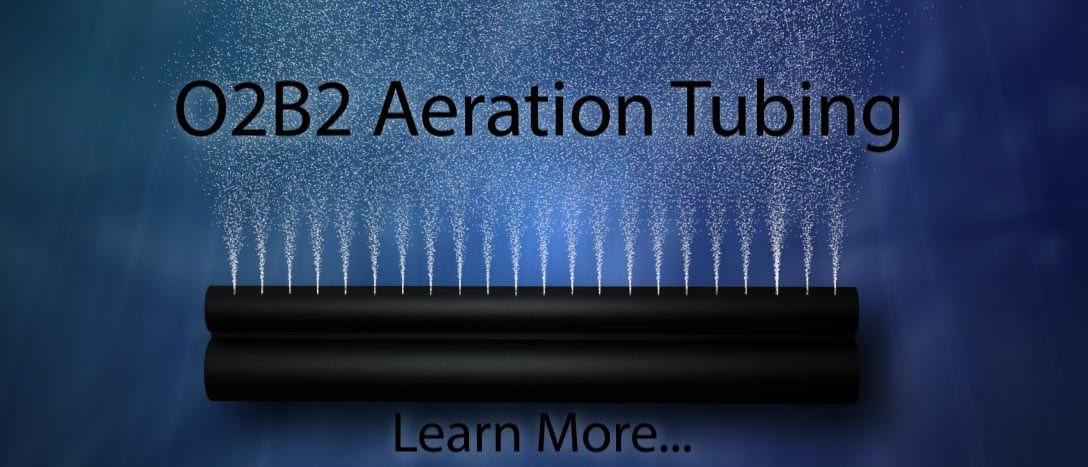Early Winter
| AERATED | NON AERATED |
|---|---|
| – ice forms on the dugout and prevents the wind from mixing the water | – ice covers the dugout and prevents the wind from mixing the water |
| – despite the absence of wind, bubbles rising from the aeration diffuser circulate the water in the entire dugout beneath the ice cover | – a small amount of oxygen diffuses through the ice but is not distributed throughout the dugout |
| – dead algae decompose consuming the oxygen at the bottom of the dugout | – dead algae at the bottom of the dugout begin to decompose consuming the oxygen at the bottom of the dugout |
| – the aeration system replaces the consumed oxygen and maintains a high concentration of oxygen throughout the entire dugout | – the oxygen is not replaced and the absence of oxygen in the water allows plant nutrients (e.g. nitrogen, phosphorus) and metals (e.g. iron, manganese) which are trapped in the sediment to dissolve into the water |
| – water quality remains good | – a layer of poor quality water which is high in nutrients and metals begins to form at the bottom of dugout |
Late Winter
| AERATED | NON AERATED |
|---|---|
| – decomposition of dead algae at the bottom of the dugout continues to use oxygen | – decompositon of algae at the bottom of the dugout continues to use oxygen |
| – the aeration system replaces any oxygen consumed by the decomposition process and ensures a high concentration of oxygen throughout the entire dugout | – the absence of oxygen results in the release of hydrogen sulfide (rotten egg smell) |
| – water quality remains good throughout winter season | – more nutrients and metals are released into the water at the bottom of the dugout and the layer of poor quality water increases in thickness |
| – the user notices taste and odour problems when the poor quality water reaches the intake and is pumped into the house for use |
Spring
| AERATED | NON AERATED |
|---|---|
| – the heat from the sun melts the ice | – the heat from the sun melts the ice and creates a uniform water temperature throughout the dugout |
| – despite the absence of wind, bubbles rising from the aeration diffuser circulate the water in the entire dugout beneath the ice cover | – the uniform temperature allows the wind to mix the dugout bringing nutrient rich water from the bottom to the surface |
| – spring runoff adds a small amount of plant nutrients to the dugout | – spring runoff adds a small amount of plant nutrients in comparison with that released from the sediment during the winter |
Early Summer
| AERATED | NON AERATED |
|---|---|
| – the sun heats the surface water but the aeration system keeps the dugout well mixed and the temperature uniform | – the sun heats the surface water which begins to float on the colder deeper water which reduces the ability of the wind to mix the water to the bottom of the dugout |
| – a small supply of plant nutrients limits algae growth | – a large supply of the plant nutrients encourages rapid algae growth |
Mid Summer
| AERATED | NON AERATED |
|---|---|
| – the aeration system and wind keeps the dugout well mixed | – the sun continues to heat the surface water preventing any mixing and limiting the mixing effect of the wind to the top few feet |
| – the limited amount of algae floating in the water allows the light to reach the bottom of the dugout encouraging the growth of rooted weeds at the bottom of the dugout | – the surface algae bloom becomes thick restricting light penetration to the top few feet and so rooted weed growth is limited to the edges of the dugout |
| – a small amount of algae dies and falls to the bottom of the dugout | – a large amount of algae dies and falls to the bottom of the dugout |
Late Summer
| AERATED | NON AERATED |
|---|---|
| – the aeration system and the wind combine to maintain high concentrations of oxygen throughout the dugout | – the wind mixes only the very top layer of the dugout. The green algae consume all of the available nitrogen, die and fall to the bottom of the dugout |
| – the dead algae at the bottom of the dugout decompose and consume oxygen but the aeration system keeps oxygen concentrations high and the dugout well mixed | – blue green algae which can grow without nitrogen become dominant. The green algae at the bottom of the dugout begin to decompose using oxygen at the bottom of the dugout which is not replaced |
| – the high concentrations of oxygen prevents nutrients and metals from dissolving into the water from the sediment | – the absence of oxygen in the water allows plant nutrients (e.g. nitrogen, phosphorus) and metals (e.g. iron, manganese) which are trapped in the sediment to dissolve into the water |
| – water quality remains high throughout the dugout | – a layer of poor quality water which is high in nutrients and metals begins to form at the bottom of dugout |
Autumn
| AERATED | NON AERATED |
|---|---|
| – the water temperature cools, all algae die and fall to the bottom of the dugout | – the surface water temperature cools creating a uniform temperature throughout the dugout. The uniform temperature allows the wind to mix the entire dugout increasing oxygen concentrations throughout the dugout |
| – the aeration system and the wind continue to maintain high concentrations of oxygen throughout the dugout | – the increased concentrations of oxygen improve the water quality of the dugout |
| – water quality remains high | – all algae die and fall to the bottom of the dugout where they begin to decompose and consume the oxygen at the bottom of the dugout |



